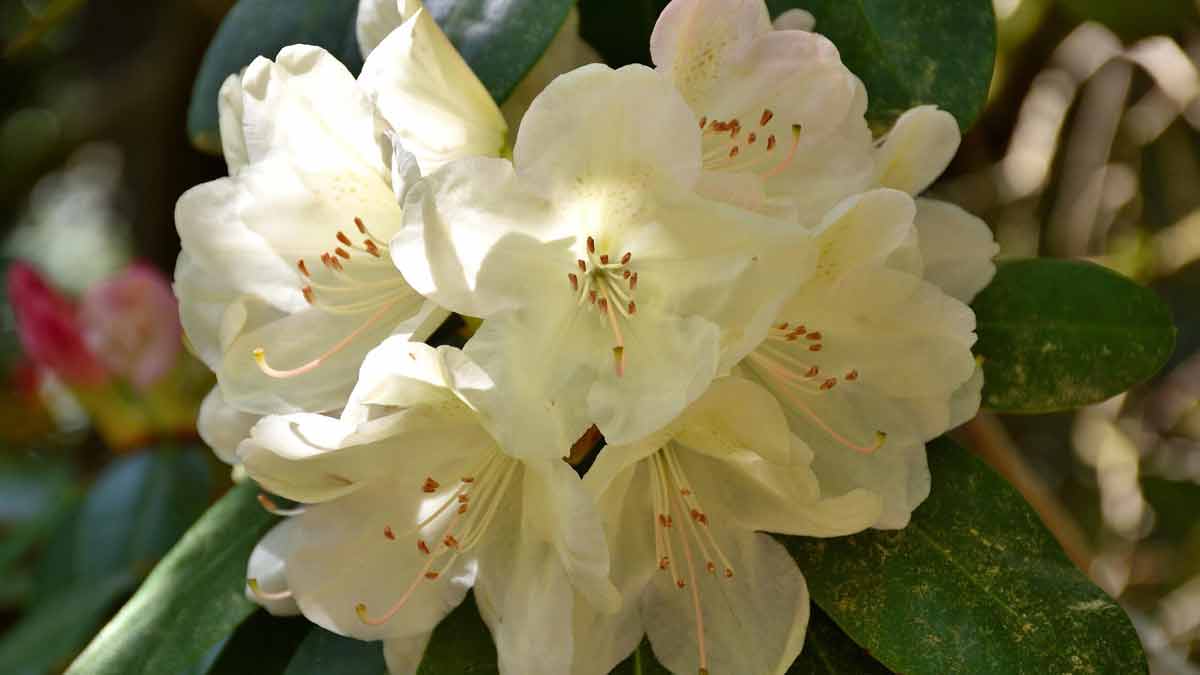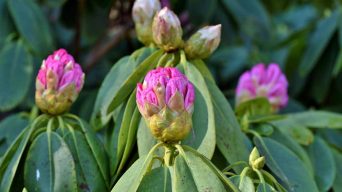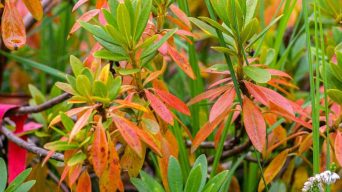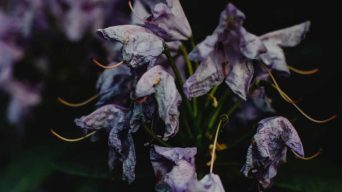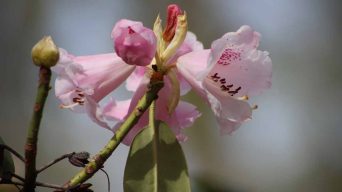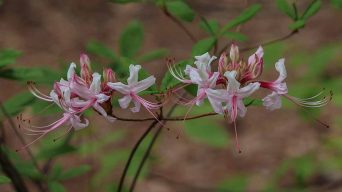Rhododendron plants are prized for their beautiful, large flowers in various colors.
These flowers bloom in the spring and summer, and the plant leaves are usually green.
However, sometimes you may notice that your rhododendron leaves have white spots on them.
There are a few different reasons why this may happen; fortunately, there are also a few solutions.
This article will discuss 6 common causes of white spots on rhododendron leaves and what you can do to fix the problem and prevent it from happening again.
What Causes White Spots on Rhododendron Leaves?
There are a few reasons your rhododendron leaves may develop white spots.
The most common causes are listed below.
1. Powdery Mildew
One of the most common reasons for white spots on rhododendron leaves is powdery mildew.
Powdery mildew is a fungal disease that affects various plants, and it usually appears as a white or gray powder on the plant’s leaves.
This fungus thrives in humid conditions, so if your rhododendron is getting too much water or not enough air circulation, it may be more susceptible to powdery mildew.
Although powdery mildew is not usually fatal to plants, it can cause the leaves to turn yellow and eventually drop off.
How To Tell If Your Rhododendron Has Powdery Mildew
Look closely at the leaves if you think your rhododendron has powdery mildew.
You should see a white or gray powder on the surface of the leaves.
The powder may be more dense in some areas than others and may also have a fuzzy appearance.
If you examine the leaves closely, you may also see tiny black dots on the surface of the powder.
These are fungal spores, and they can be easily spread to other plants.
The white spots will spread quickly if the fungus is left unchecked, so it’s essential to take action as soon as you notice them.
How To Treat Powdery Mildew
If your rhododendron has powdery mildew, you’ll need to take action to treat the problem and prevent it from spreading.
There are a few different ways you can do this:
1. Use a Homemade Solution
You can make your own powdery mildew treatment with ingredients you probably already have at home.
Mix equal parts of water and baking soda and apply it to the affected leaves.
This solution will kill the fungus and help to prevent it from spreading.
2. Use a Neem Oil Solution
Neem oil is another effective treatment for powdery mildew.
Mix 1 teaspoon of neem oil with 1 quart of water and spray it on the affected leaves.
Neem oil is a natural fungicide that will help kill the fungus and prevent it from spreading.
3. Use Milk
Milk is also effective at treating powdery mildew.
Mix 1 part milk with 3 parts water and spray it on the affected leaves.
This solution will help to kill the fungus and prevent it from spreading.
4. Use a Commercially Available Fungicide
If you can’t find neem oil or baking soda, you can also use a commercially available fungicide.
There are many different products on the market, so read the label carefully to find one specifically for powdery mildew.
Apply the fungicide according to the instructions on the label.
5. Remove Infected Leaves
Another way to treat powdery mildew is to remove the infected leaves from the plant.
This will help prevent the fungus from spreading and allow the plant to focus its energy on producing new, healthy leaves.
To remove the leaves, cut them off at the base of the infected plant.
Be sure to dispose of the leaves in a trash bag, so the fungus doesn’t spread to other plants.
Don’t compost the leaves, as the fungus can survive in compost and infect other plants.
How To Prevent Powdery Mildew
Once you’ve treated the powdery mildew on your rhododendron, you’ll need to take steps to prevent it from coming back.
Here are a few things you can do:
1. Improve Air Circulation
Powdery mildew thrives in humid conditions, so it’s essential to make sure your rhododendron has good air circulation.
Prune the plant to improve air circulation and ensure other plants do not crowd it.
2. Avoid Overwatering
Overwatering is one of the most common reasons for powdery mildew, so be sure to water your rhododendron only when the soil is dry.
3. Place The Plant In The Sun
Powdery mildew loves shady, humid conditions, so placing your rhododendron in the sun will help to prevent it from developing.
4. Remove Dead Leaves
Dead leaves can provide a perfect environment for powdery mildew to grow, so be sure to remove them from the plant.
5. Disinfect Your Tools
If you’ve had powdery mildew in the past, clean and disinfect your gardening tools before using them on other plants.
This will help to prevent the fungus from spreading.
2. Pest Infestation
Another common cause of white spots on rhododendron leaves is a pest infestation.
Many pests can infest rhododendrons, including mealybugs, scale insects, and whiteflies.
These pests suck the sap from the leaves, causing them to turn white.
They can also cause the leaves to turn yellow, brown, or black.
How To Tell If Your Rhododendron Has A Pest Infestation
There are a few telltale signs that your rhododendron has a pest infestation:
- Sticky leaves: If you notice that the leaves of your rhododendron are sticky, it’s a sure sign that there are pests present. This sticky substance is called honeydew, and aphids, mealybugs, and whiteflies excrete it.
- White spots on the leaves: Another sign of a pest infestation is white spots on the leaves. These spots look like powdery mildew, but scale insects cause them.
- Damaged leaves: Pests can also damage the leaves of your rhododendron, causing them to turn yellow, brown, or black.
- Curling or yellowing leaves: Pests can also cause the leaves of your rhododendron to turn yellow or brown and curl up.
- Honeydew: As mentioned above, honeydew is a sticky substance excreted by aphids, mealybugs, and whiteflies. It can attract ants and wasps to your rhododendron, so if you see it on the leaves, it’s a sure sign of a pest infestation.
How To Treat A Pest Infestation
If you think your rhododendron has a pest infestation, there are a few things you can do to treat it:
- Make sure to identify the pests that are infesting your plant. This will help you choose the proper treatment method.
- Try to remove the pests by hand. Use a cotton swab dipped in rubbing alcohol to kill the pests.
- Use insecticidal soap or neem oil to kill the pests. Be sure to follow the instructions on the label.
- Bring beneficial insects, such as ladybugs and green lacewings, to eat the pests.
- Prune heavily infested leaves.
How To Prevent Pest Infestation
The best way to prevent a pest infestation is to keep your plant healthy. A healthy rhododendron is less likely to be attacked by pests.
Here are a few things you can do to keep your rhododendron healthy:
- Provide the right amount of water. Water your rhododendron when the soil is dry.
- Provide the right amount of light. Rhododendrons need at least 4 hours of sunlight per day.
- Prune regularly. Prune your rhododendron to improve air circulation and remove dead leaves.
- Inspect your plant regularly. Check your rhododendron for pests every week.
- Quarantine new plants. If you’re adding a new plant to your garden, isolate it for at least 2 weeks. This will help to prevent the spread of pests and diseases.
- Keep your garden clean. Remove dead leaves and debris from your garden. This will help to prevent the spread of pests and diseases.
3. Sunburn
Another common cause of white spots on rhododendron leaves is sunburn.
Rhododendrons are shade-loving plants, so they can be sensitive to direct sunlight.
If the leaves are exposed to direct sunlight for too long, they can become sunburned.
This will cause the leaves to turn white or yellow.
How To Tell If Your Rhododendron Has Sunburn
There are a few telltale signs that your rhododendron has sunburn:
- White or yellow spots on the leaves: The most obvious sign of sunburn is white or yellow spots on the leaves.
- Leaves that are wilted or drooping: Sunburned leaves will often be wilted or drooping.
- Cracked or peeling bark: If the sunburn is severe, you may also notice that the bark of your rhododendron is cracked or peeling.
- Leaves that are dry or brown: Sunburned leaves will often be dry or brown.
How To Treat Sunburn
If your rhododendron has sunburn, there are a few things you can do to treat it:
- Prune the affected leaves. Remove any leaves that are white or yellow.
- Provide the plant with indirect sunlight. Move your rhododendron to an area where it will receive indirect sunlight.
- Water the plant regularly. Water your rhododendron when the soil is dry.
How To Prevent Sunburn
The best way to prevent sunburn is to provide your rhododendron with the right amount of light.
Rhododendrons need at least 4 hours of sunlight per day.
If you live in an area with very hot summers, you may need to provide your rhododendron with some afternoon shade.
You can also protect your rhododendron from sunburn by using a sunshade or placing it in a pot that has been painted white.
4. Mineral Deposits
Another common cause of white spots on rhododendron leaves is mineral deposits.
Mineral deposits can build up on the leaves of your rhododendron if the water you’re using to water the plant is high in minerals.
The most common type of mineral deposit is calcium carbonate, which can be found in hard water.
Calcium carbonate deposits appear as white spots on the leaves of your rhododendron.
How To Tell If Your Rhododendron Has Mineral Deposits
There are a few telltale signs that your rhododendron has mineral deposits:
- The white spots on the leaves are raised and have a crusty texture.
- The spots are found mainly on the upper surface of the leaves.
- The spots are more common on newer leaves.
- The leaves may turn yellow and drop off if the deposits are severe.
How To Treat Mineral Deposits On Rhododendron Leaves
The best way to treat mineral deposits on rhododendron leaves is to flush the leaves with water.
You can do this by setting your hose to a gentle spray and holding it close to the affected leaves.
Let the water run over the leaves for a few minutes to remove the deposits.
You may need to do this a few times to remove all deposits.
You can also try removing the affected leaves if the deposits are severe.
How To Prevent Mineral Deposits On Rhododendron Leaves
The best way to prevent mineral deposits on rhododendron leaves is to use distilled water or rainwater to water the houseplant.
If you can’t use distilled water or rainwater, let tap water sit for 24 hours before watering your rhododendron.
This will allow the minerals in the water to settle to the bottom of the container, making the water less concentrated.
You can also add a water softener to your watering routine if you live in an area with hard water.
A water softener will remove the minerals from the water before you use it to water your rhododendron.
5. Chemical Burns
Chemical burns are another common cause of white spots on rhododendron leaves.
Chemical burns can occur if you use a chemical fertilizer that is too strong or an herbicide or pesticide that is too strong.
Chemical burns appear as white spots on the leaves of your rhododendron.
The spots may be raised and have a crusty texture.
The leaves may turn yellow and drop off if the burns are severe.
How To Tell If Your Rhododendron Has Chemical Burns
There are a few signs that your rhododendron has chemical burns:
- The leaves have white spots that are raised and crusty.
- The leaves turn yellow and drop off.
- You have recently used a chemical fertilizer, herbicide, or pesticide.
- The white spots are located where you applied the chemical.
How To Treat Chemical Burns
If you think your rhododendron has chemical burns, you should take the following steps:
- Stop using the chemical fertilizer, herbicides, or pesticides.
- Flush the area with water to remove any chemicals still on the leaves.
- Prune off any leaves that are damaged.
- Dispose of the leaves in a plastic bag, so they don’t contaminate other plants.
- Apply a diluted solution of water and vinegar to the area to neutralize the chemicals.
How To Prevent Chemical Burns
There are a few things you can do to prevent chemical burns on your rhododendron:
- Read the labels of all fertilizers, herbicides, and pesticides before using them.
- Follow the directions on the labels.
- Don’t use more than the recommended amount.
- Apply chemicals early morning or evening when the sun is not as intense.
- Do a test patch on a small area of the plant before applying chemicals to the entire plant.
- Monitor the plants after applying chemicals to ensure they are not showing signs of stress.
6. Nutrient Deficiency
A nutrient deficiency is another common cause of white spots on rhododendron leaves.
Rhododendrons need a specific balance of nutrients to stay healthy.
If they don’t get enough of one nutrient, it can cause a deficiency.
Iron, magnesium, and manganese are the most common nutrient deficiencies that cause white spots on rhododendron leaves.
These deficiencies cause the leaves to turn yellow or white.
The spots may be small or large and may be random or clustered together.
The spots may also have a raised or crinkled appearance.
How To Tell If Your Rhododendron Has A Nutrient Deficiency
There are a few signs that your rhododendron has a nutrient deficiency:
- The leaves are smaller than normal
- The leaves are a lighter green than normal
- There are white spots on the leaves
- The plant is not blooming as much as it should be
If you notice any of these signs, you must take action immediately.
How To Treat A Nutrient Deficiency
If you think your rhododendron has a nutrient deficiency, you should take the following steps:
- Test the soil to see which nutrients are lacking.
- Apply a fertilizer that is high in the nutrient that is lacking.
- Follow the directions on the fertilizer label.
- Monitor the plant to make sure the deficiency is corrected.
How To Prevent A Nutrient Deficiency
There are a few things you can do to prevent nutrient deficiencies in your rhododendron:
- Apply a balanced fertilizer to the plant during the growing season.
- Don’t overfertilize the plant.
- Add compost to the soil to improve the nutrient content.
- Test the soil regularly to ensure it does not lack any nutrients.
- Water the plant regularly so the roots can absorb nutrients from the soil.
- Monitor the plant for signs of stress and take action immediately if you see any.
Final Thoughts
Rhododendron plants are generally tough and can withstand a lot of abuse, but they are not invulnerable.
Pests, diseases, and environmental stressors can all cause problems for these beautiful plants.
If you see white spots on the leaves of your rhododendron, it’s essential to take action quickly to prevent further damage.
The problem can be remedied in most cases with simple changes to your gardening routine.
With proper care, your rhododendron will soon look as good as new.

